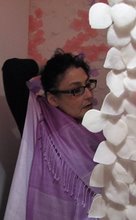Suspensions/ suspensiones explores the concept of maps as identifiers of cultural, economic and ethnic topographies. In 2005 I spent 6 months in Mendoza, Argentina working in my studio and with a beekeeper. As a result, I created a site-specific piece using a world map made of 256 discarded honey wax combs from Mendoza. The 3 D map I am submitting was rendered using the Grerardus Mercator map from 1569 that has been in use since then “representing” the world. The Mercator's projection (created at a time when navigators were sailing on the oceans in wooden ships, powered by the wind, and navigating by the stars) was particularly useful because the straight lines on his projection were lines of constant compass bearing. Today the Mercator projection still remains useful for navigational purposes and is referred to by seafarers and airline pilots. The Mercator is also a "conformal" map projection. This means that it shows shapes pretty much the way they appear on the globe. The mapmaker's dilemma is that he/she cannot show both shape and size accurately. If you want a true shape for the landmasses you will necessarily sacrifice proportionality, i.e., the relative sizes will be distorted. The Mercator map is considered the icon of Western superiority. This popular and “general purpose” map of the world has been used to represent the world in most parts of the world. Because the Mercator projection distorts size so much at the poles it is common to crop Antarctica off the map. This practice results in the Northern Hemisphere appearing much larger than it really is. Typically, the cropping technique results in a map showing the equator about 60% of the way down the map, diminishing the size and importance of the developing countries. Suspensions analyses the many interpretations of maps considering that maps serve as guides not only to the physical terrain but also and more importantly as charts of the mapmaker's mental and cultural terrain, of the memories and desires, anxieties and assumptions he/she projects upon any terra incognita. Using bee’s wax as the material for the piece I had the freedom of randomly modeling the world, using an organic material that eventually moths will devour.















